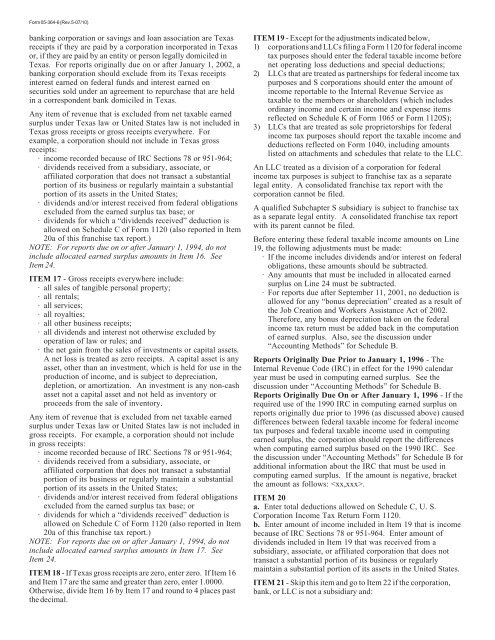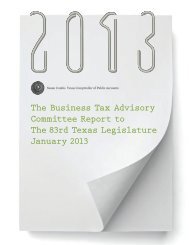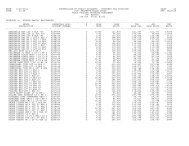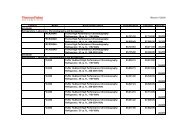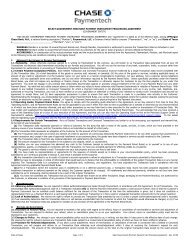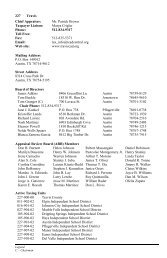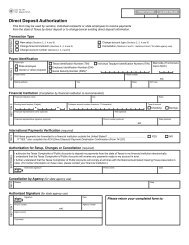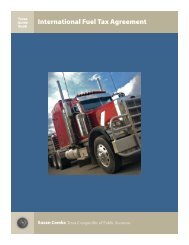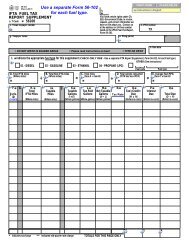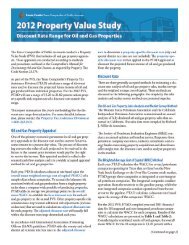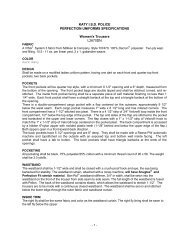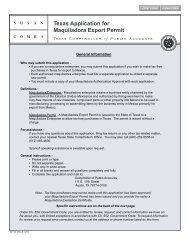Instructions for completing franchise tax reports originally due
Instructions for completing franchise tax reports originally due
Instructions for completing franchise tax reports originally due
Create successful ePaper yourself
Turn your PDF publications into a flip-book with our unique Google optimized e-Paper software.
Form 05-364-6 (Rev.5-07/10)banking corporation or savings and loan association are Texasreceipts if they are paid by a corporation incorporated in Texasor, if they are paid by an entity or person legally domiciled inTexas. For <strong>reports</strong> <strong>originally</strong> <strong>due</strong> on or after January 1, 2002, abanking corporation should exclude from its Texas receiptsinterest earned on federal funds and interest earned onsecurities sold under an agreement to repurchase that are heldin a correspondent bank domiciled in Texas.Any item of revenue that is excluded from net <strong>tax</strong>able earnedsurplus under Texas law or United States law is not included inTexas gross receipts or gross receipts everywhere. Forexample, a corporation should not include in Texas grossreceipts:· income recorded because of IRC Sections 78 or 951-964;· dividends received from a subsidiary, associate, oraffiliated corporation that does not transact a substantialportion of its business or regularly maintain a substantialportion of its assets in the United States;· dividends and/or interest received from federal obligationsexcluded from the earned surplus <strong>tax</strong> base; or· dividends <strong>for</strong> which a “dividends received” deduction isallowed on Schedule C of Form 1120 (also reported in Item20a of this <strong>franchise</strong> <strong>tax</strong> report.)NOTE: For <strong>reports</strong> <strong>due</strong> on or after January 1, 1994, do notinclude allocated earned surplus amounts in Item 16. SeeItem 24.ITEM 17 - Gross receipts everywhere include:· all sales of tangible personal property;· all rentals;· all services;· all royalties;· all other business receipts;· all dividends and interest not otherwise excluded byoperation of law or rules; and· the net gain from the sales of investments or capital assets.A net loss is treated as zero receipts. A capital asset is anyasset, other than an investment, which is held <strong>for</strong> use in theproduction of income, and is subject to depreciation,depletion, or amortization. An investment is any non-cashasset not a capital asset and not held as inventory orproceeds from the sale of inventory.Any item of revenue that is excluded from net <strong>tax</strong>able earnedsurplus under Texas law or United States law is not included ingross receipts. For example, a corporation should not includein gross receipts:· income recorded because of IRC Sections 78 or 951-964;· dividends received from a subsidiary, associate, oraffiliated corporation that does not transact a substantialportion of its business or regularly maintain a substantialportion of its assets in the United States;· dividends and/or interest received from federal obligationsexcluded from the earned surplus <strong>tax</strong> base; or· dividends <strong>for</strong> which a “dividends received” deduction isallowed on Schedule C of Form 1120 (also reported in Item20a of this <strong>franchise</strong> <strong>tax</strong> report.)NOTE: For <strong>reports</strong> <strong>due</strong> on or after January 1, 1994, do notinclude allocated earned surplus amounts in Item 17. SeeItem 24.ITEM 18 - If Texas gross receipts are zero, enter zero. If Item 16and Item 17 are the same and greater than zero, enter 1.0000.Otherwise, divide Item 16 by Item 17 and round to 4 places pastthe decimal.ITEM 19 - Except <strong>for</strong> the adjustments indicated below,1) corporations and LLCs filing a Form 1120 <strong>for</strong> federal income<strong>tax</strong> purposes should enter the federal <strong>tax</strong>able income be<strong>for</strong>enet operating loss deductions and special deductions;2) LLCs that are treated as partnerships <strong>for</strong> federal income <strong>tax</strong>purposes and S corporations should enter the amount ofincome reportable to the Internal Revenue Service as<strong>tax</strong>able to the members or shareholders (which includesordinary income and certain income and expense itemsreflected on Schedule K of Form 1065 or Form 1120S);3) LLCs that are treated as sole proprietorships <strong>for</strong> federalincome <strong>tax</strong> purposes should report the <strong>tax</strong>able income anddeductions reflected on Form 1040, including amountslisted on attachments and schedules that relate to the LLC.An LLC treated as a division of a corporation <strong>for</strong> federalincome <strong>tax</strong> purposes is subject to <strong>franchise</strong> <strong>tax</strong> as a separatelegal entity. A consolidated <strong>franchise</strong> <strong>tax</strong> report with thecorporation cannot be filed.A qualified Subchapter S subsidiary is subject to <strong>franchise</strong> <strong>tax</strong>as a separate legal entity. A consolidated <strong>franchise</strong> <strong>tax</strong> reportwith its parent cannot be filed.Be<strong>for</strong>e entering these federal <strong>tax</strong>able income amounts on Line19, the following adjustments must be made:· If the income includes dividends and/or interest on federalobligations, these amounts should be subtracted.· Any amounts that must be included in allocated earnedsurplus on Line 24 must be subtracted.· For <strong>reports</strong> <strong>due</strong> after September 11, 2001, no deduction isallowed <strong>for</strong> any “bonus depreciation” created as a result ofthe Job Creation and Workers Assistance Act of 2002.There<strong>for</strong>e, any bonus depreciation taken on the federalincome <strong>tax</strong> return must be added back in the computationof earned surplus. Also, see the discussion under“Accounting Methods” <strong>for</strong> Schedule B.Reports Originally Due Prior to January 1, 1996 - TheInternal Revenue Code (IRC) in effect <strong>for</strong> the 1990 calendaryear must be used in computing earned surplus. See thediscussion under “Accounting Methods” <strong>for</strong> Schedule B.Reports Originally Due On or After January 1, 1996 - If therequired use of the 1990 IRC in computing earned surplus on<strong>reports</strong> <strong>originally</strong> <strong>due</strong> prior to 1996 (as discussed above) causeddifferences between federal <strong>tax</strong>able income <strong>for</strong> federal income<strong>tax</strong> purposes and federal <strong>tax</strong>able income used in computingearned surplus, the corporation should report the differenceswhen computing earned surplus based on the 1990 IRC. Seethe discussion under “Accounting Methods” <strong>for</strong> Schedule B <strong>for</strong>additional in<strong>for</strong>mation about the IRC that must be used incomputing earned surplus. If the amount is negative, bracketthe amount as follows: .ITEM 20a. Enter total deductions allowed on Schedule C, U. S.Corporation Income Tax Return Form 1120.b. Enter amount of income included in Item 19 that is incomebecause of IRC Sections 78 or 951-964. Enter amount ofdividends included in Item 19 that was received from asubsidiary, associate, or affiliated corporation that does nottransact a substantial portion of its business or regularlymaintain a substantial portion of its assets in the United States.ITEM 21 - Skip this item and go to Item 22 if the corporation,bank, or LLC is not a subsidiary and:


